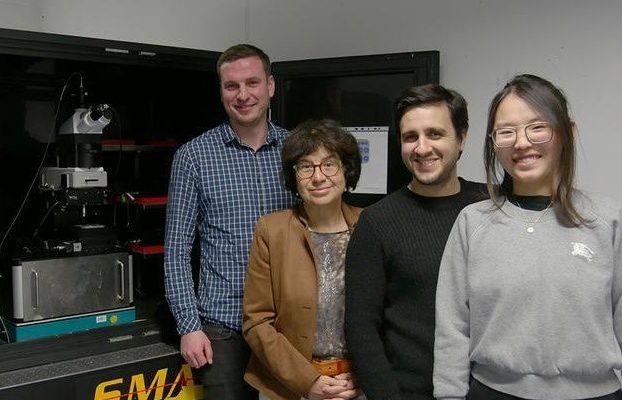The optimization of electrochemical reactions is an important lever for the transition to renewable energy and carbon sources. In electrochemical reactions, chemical reactions are induced by applying an electrical potential. This chemistry forms the basis for numerous applications, including producing hydrogen and storing energy in batteries. Although many questions have been addressed in this area in recent years, there is still potential for further improvements. Researchers from the RESOLV Cluster of Excellence at the Ruhr University Bochum and the École Normale Supérieure in Paris have found two new aspects for controlling and thus optimizing electrochemical reactions at interfaces. They describe their findings in the Journal of the American Chemical Society on April 10, 2024. The article was selected for the journal’s cover page.
The authors from the Cluster of Excellence RESOLV: Steffen Murke, Martina Havenith, Simone Pezzotti and Wanlin Chen (from left)
© RESOLV, Kasper
Surface sensitive spectroscopy
To understand the complex behavior at interfaces, the team examined an important parameter in electrochemical reactions, the so-called acid constant (pKa), at electrified metal surfaces/water interfaces. This value is well known in the solution. “However, there has been speculation that this value, which is crucial for the reaction, differs near an electrode from that in a solution,” explains Prof. Dr. Martina Havenith-Newen, spokeswoman for RESOLV. To measure pKa values under electrochemical conditions, her team used special, surface-specific spectroscopic techniques – Surface-Enhanced Raman Spectroscopy (SERS) – and compared the results with theoretical modeling. The researchers were thus able to uncover significant deviations from the acid-base chemistry at electrified interfaces as a function of the applied voltage, which differ from the known processes in the solution.
Local water networks and strong electric fields
In the publication, they describe two new key mechanisms that influence acid-base reactions at electrified interfaces: the influence of the local water structure at the electrode and the strong local electric fields. Using the example of the amino acid glycine, the protonation/deprotonation was measured as a function of the applied fields and a destabilization of the zwitterion was observed. “The results show the changes in the local solvation properties at metal/water interfaces and open up new possibilities for optimizing reactivity in electrochemistry,” says Martina Havenith. “These findings offer new opportunities to develop strategies for catalysis, as the two crucial factors – local water structures and electric fields – can be manipulated.

